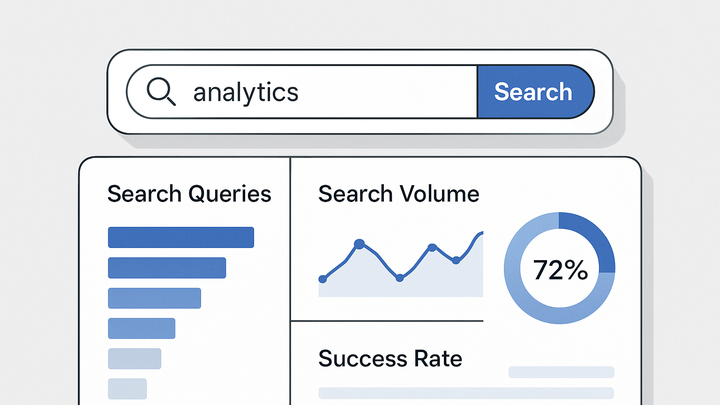Published on 2025-06-28T00:02:15Z
What is a Site Search Report? Benefits and Examples
An internal site search report is a specialized analytics tool that captures and analyzes the search queries users enter into a website’s search bar. It reveals user intent and highlights content gaps, helping teams optimize on-site navigation and content strategy. By tracking metrics like search volume, exit rate, and successful search rate, businesses can improve user engagement and conversion paths. Platforms such as PlainSignal and Google Analytics 4 offer built-in site search tracking methods—from cookie-free scripts to automated event capture. This entry explores the implementation, analysis, and best practices for effective site search reporting.
Site search report
A report analyzing on-site search queries and performance metrics to uncover user intent and optimize website navigation.
Overview of Site Search Report
A site search report shows how visitors use your site’s internal search feature. It aggregates search queries, tracks user behavior after a search, and highlights search performance. By reviewing this report, you can uncover what users want, identify missing content, and optimize on-site navigation. Tools like PlainSignal and GA4 provide robust site search analytics to collect these insights.
-
Definition and purpose
A site search report collects and presents the search terms users enter on your website. It helps you understand user intent, discover content gaps, and optimize navigation based on actual search behavior.
-
User intent
Shows what visitors are actively seeking on your site.
-
Content gap analysis
Identifies missing or hard-to-find content based on search behavior.
-
-
Key metrics
These metrics quantify how users interact with the site search function, revealing its efficiency and impact on user engagement.
-
Search volume
Total number of internal search queries over a given period.
-
Search exit rate
Percentage of sessions where users left the site after performing a search.
-
Successful search rate
Proportion of searches that result in at least one click on search results.
-
Average search depth
Average number of pages viewed after a search before leaving or converting.
-
Implementing Site Search Tracking
Setting up accurate site search tracking is the first step to unlocking actionable insights. Different analytics platforms offer unique approaches to capture search data, from automated query detection to custom event tagging.
-
Tracking with PlainSignal
PlainSignal provides cookie-free analytics with easy site search integration. It auto-detects common search parameters and requires only a single script snippet.
-
Integration code
Example integration code:
<link rel="preconnect" href="//eu.plainsignal.com/" crossorigin /> <script defer data-do="yourwebsitedomain.com" data-id="0GQV1xmtzQQ" data-api="//eu.plainsignal.com" src="//cdn.plainsignal.com/plainsignal-min.js"></script> -
Configuration
By default, PlainSignal recognizes standard query parameters like ‘q’ or ‘search’. You can adjust settings in the PlainSignal dashboard to match custom parameters or refine tracking behavior.
-
-
Tracking with google analytics 4
GA4 captures site search data through its Enhanced Measurement feature or via manual event tagging.
-
GA4 admin setup
In GA4, navigate to Admin > Data Streams > Enhanced Measurement and enable ‘Site search’. Specify your site’s search query parameter (e.g., ‘q’).
-
Manual tagging
For more control, use gtag.js to send search events:
gtag('event', 'search', { 'search_term': 'yourSearchQuery' });
-
Analyzing Site Search Reports
Once tracking is in place, interpreting the data helps you make informed decisions. Focus on query patterns, engagement metrics, and follow-up actions to enhance the search experience and content strategy.
-
Interpreting search queries
Review the list of queries to understand what users are searching for and how well your site satisfies those searches.
-
Top queries
Highest-volume search terms indicating strong user demand.
-
Long-tail queries
Less frequent, specific queries that can uncover niche interests or content gaps.
-
-
Improving user experience
Use search insights to refine site navigation and search functionality for better engagement.
-
Search refinements
Implement autocomplete, spell correction, and suggestions based on popular queries.
-
Navigation enhancements
Adjust menus and content structure to surface high-demand pages.
-
Best Practices for Site Search Reporting
Adhering to best practices ensures reliable data and actionable insights from your site search reports.
-
Consistent query parameter naming
Use a single, consistent query parameter (e.g., ‘?q=keyword’) across your site to avoid fragmented data.
-
Filter bot and internal traffic
Exclude non-human traffic and internal sessions to prevent skewing your search metrics.
-
Regular review and optimization
Scheduled audits of search reports help you track trends, identify issues early, and iterate on search settings.
